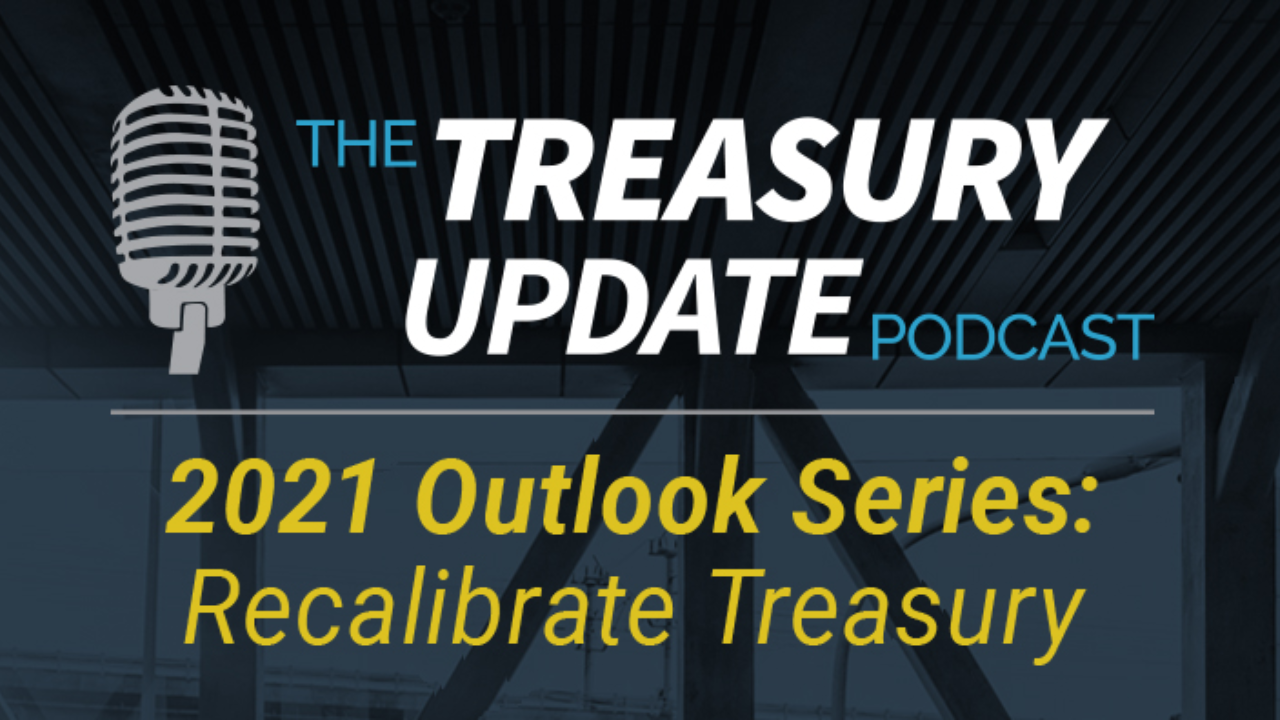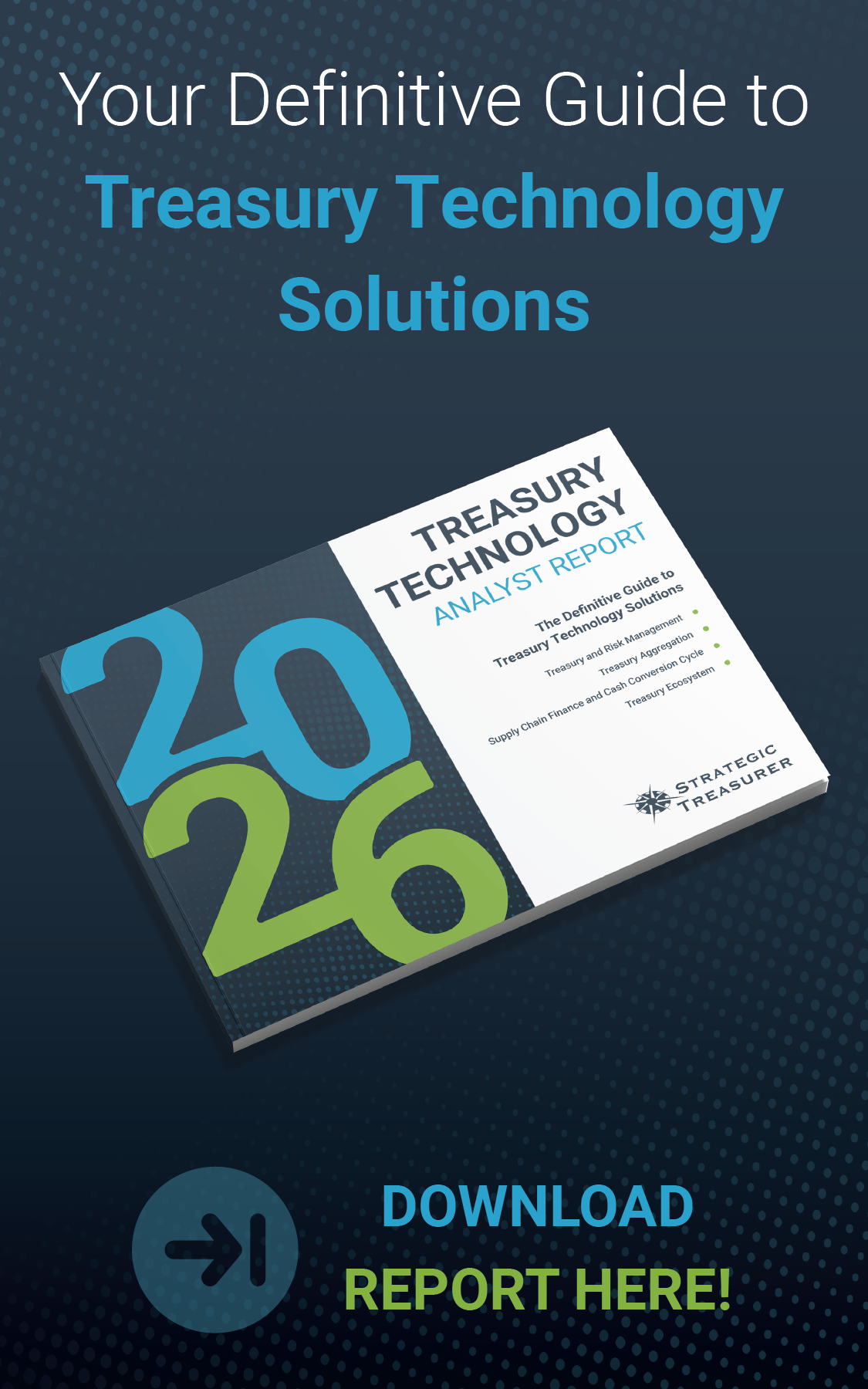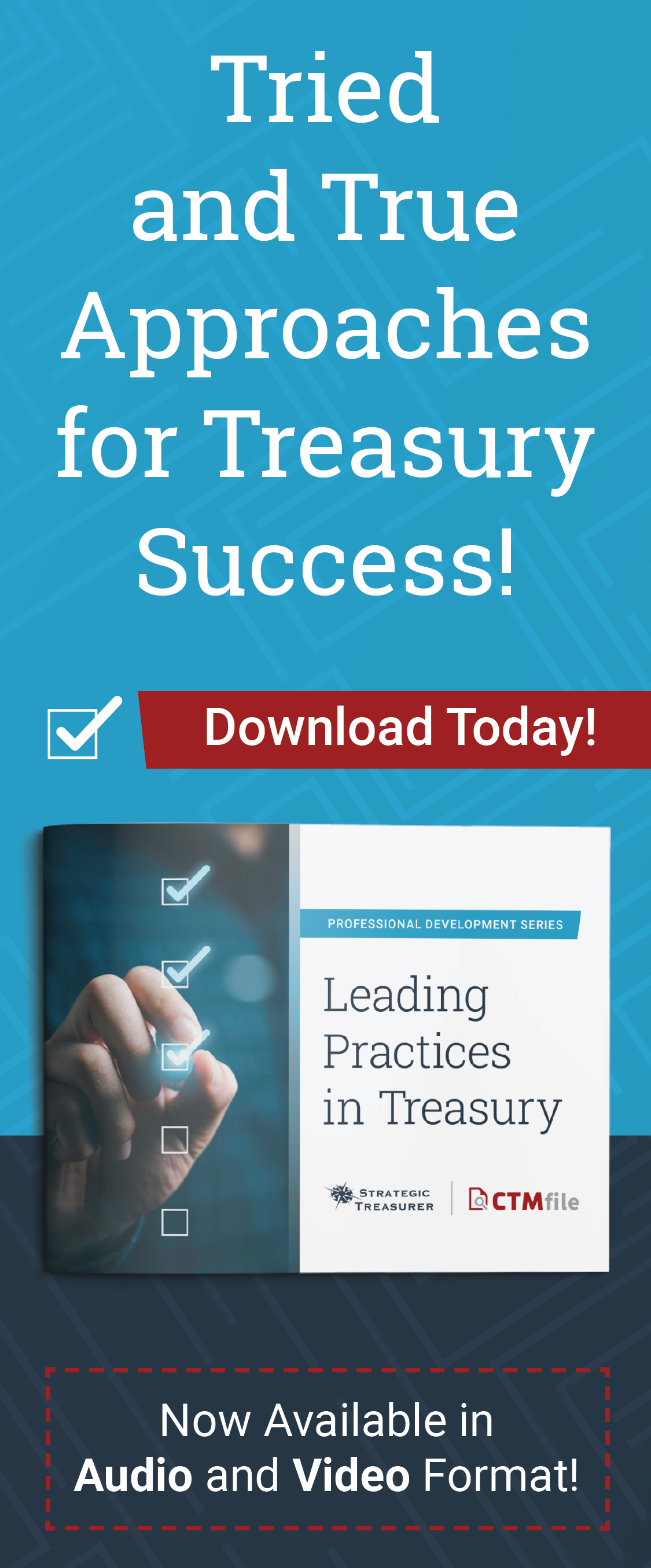
Episode 152
Thoughts on Technology: An Interview with Microsoft’s George Zinn
Host:
Craig Jeffery, Strategic Treasurer


Speaker:
George Zinn, Microsoft Corporation


Subscribe to the Treasury Update Podcast on your favorite app!
Episode Transcription - Episode #
Welcome to The Treasury Update Podcast, presented by Strategic Treasurer, your source for interesting Treasury News Analysis and insights in your car at the gym, or wherever you decide to tune in. On this episode of the 2021 outlook series host Craig Jeffery interviews in George Zinn then Microsoft’s retired Corporate Vice President and Treasurer. They explore his career journey in Treasury, reflect on technology across several decades, and his perspective of what differentiates aspiring treasurers. Listen into this engaging conversation to find out more.
Craig Jeffery 0:44
George Zinn, welcome to the Treasury update podcast.
George Zinn 0:48
I really appreciate your time, Craig, thank you.
Craig Jeffery 0:51
I appreciate you taking some time to talk. And I know we’re gonna talk about tech. But you said you wanted to grill me on some things too. What would you like to grill me on?
George Zinn 1:00
Well, I’m not gonna call it grilling, but I was I was trying to recall, as we were preparing as to when we first met, it had to have been more than 15 years ago.
Craig Jeffery 1:11
It was, I think we met when we were, it was at an Alexander Hamilton awards event or one of the ones that treasury and risk was doing. We met, we spoke, and we seem to run into each other at those quite a bit. And that was, yeah, that was probably 15, maybe more than that ago. I think that’s what started our connections with you and Anita and some of the other folks.
George Zinn 1:39
And then we almost launched a business together at one point.
Craig Jeffery 1:45
We did. We did a lot of stuff with, you know, your BI stack. Yeah, those were pretty exciting, interesting times, you’ve always been, you’ve always been good to us.
George Zinn 2:00
Apropos of you know, talking about technology, it would have been interesting if we were able to get that done.
Craig Jeffery 2:07
Yeah, well, you know, it’s interesting, so much of that seemed so far ahead of what people were ready for at the time. And I think people now start to think about data connections, associations that, you know, everyone thought maybe in rows and columns in the past, and we were doing things with maps. And you and your team and some other people really caught the idea and others are like, “I don’t know that we would need that.” And now people are like, “Hey, we need a data lake, we need to visualize how this stuff connects.” And data has continued to double every couple of years. And now we got to get our arms around it.
George Zinn 2:52
You’re reminding me that was when we got we’ve mapped all the bank accounts on a on a Bing Maps, so that you could click on them and see the balance. That was pretty novel. I don’t remember what year that was.
Craig Jeffery 3:04
That was I think, more than 10 years ago. It was a long time ago; you could see it on the maps by type of accounts. Right? Just some just some great visualization. So, that was that was a lot of fun. I think we even had a research embedded in it with pulling up country level reports.
George Zinn 3:26
Yeah, right. The credit risk team was using that for credit limits.
Craig Jeffery 3:32
Yeah, yes. neat stuff. I thought you were gonna grill me this was this was pretty easy. I was thinking did you or did you not?
George Zinn 3:47
That’s what I’m afraid of.
Craig Jeffery 3:51
I’m not going to grill you. I’ll ask you questions that are all up your alley. I won’t try to stump you. But, but yeah, we’ll look go from there. I think this is your first podcast. You speak all the time. Everywhere. This is your first podcast.
George Zinn 4:09
That is correct.
Craig Jeffery 4:11
So, this is good. So, but you’ve been talking your whole life so we should be in good shape. Now, everyone’s familiar with Microsoft. Most people in Treasury are familiar with George Zinn to some extent, whether it’s from the broader team at Microsoft winning awards, etc. But I don’t know if everybody knows your journey in Treasury. We spoke about this a little bit before, and I know some of it and I was wondering if you could give us an overview of your journey in Treasury. I know it didn’t start at Microsoft though. Maybe that’s where most people know you more from.
George Zinn 4:50
Sure. You don’t get much credit for anything before Microsoft, but I had been working 10 years out of school prior to that. You know, it is interesting because I recently read the Steve Jobs, Stanford graduation speech. And I don’t know if you’re familiar with that it’s worth a browse. He talks about the apparently random walk of his career, and then refers to it as the long look back. And the long look back at everything makes perfect sense. So, one example in there was, he monitored a class on calligraphy in school. And as a result, that’s one of the reasons that you have such wonderful fonts in the Mac. That is fascinating to me, because when I started, I did not come out of the womb, like others, thinking I was going to be a doctor or what have you. So, when I graduated school, I’m from Detroit, and Detroit was flat on its back at the time. And, so like, many of my classmates, I ended up in Chicago. Through an accident of the universe, I ended up on the floor of the Chicago Mercantile Exchange. And in another accident of the universe, I ended up in the currencies. Reality is, that’s where I really had my first post-college work. I worked for Shearson, then Lehman, then Shearson, Lehman & Hotton, never changing firms or people just through mergers, and ultimately, migrated out to the east coast in the New York area working for what would be today called hedge funds. But in yesteryear, or maybe last century, they were referred to as commodity trading advisors. And it was really buyside investing. And the remarkable thing about my experience is that in order to land a role I took the first opportunity, which was a back office job. And we worked, actually in Lotus 123, in allocating trades across separately managed accounts. And I moved, I was able to move up, move through the middle office, and then ultimately to the trader Evaluation Program at a firm called Tryton. People may or may not be familiar with, but it’s really a number of folks that were funded by commodities corporation that was ultimately purchased by Goldman. And as a result of that experience, I really look back, I believe that, you know, landing in the currency, you know, really created the opportunity, I jumped to fall through the cracks of Microsoft, because they were looking for, they had a real high class problem, they had a lot of USD, and a lot of foreign currency that they were trying to convert and mitigate risk with. And in addition to that, I had been working, as I said, cutting my teeth on Lotus 123, but also started moving to Excel. And in my work in Excel, I was writing what would be referred to as trend following trading systems. And, you know, the irony is, I used to call Microsoft and try and reach the Excel people and ask for features and I wasn’t confused that they weren’t, you know, they were putting the features in for everyone, but they certainly were chunking out things at a very rapid pace. And Excel became the go to tool. But I think the point of that story is that again, it differentiated me from all the other people that ended up speaking at Microsoft in the mid-90s.
Craig Jeffery 9:08
To what part differentiate you the FX or the talking to them regularly about the needs?
George Zinn 9:14
Well, I think the FX was, again, an action in the universe. having that experience, the differentiation, what I was referring to is the skill sets that I was probably by accident at the time developing, just because I was trying to create the next world’s greatest trend following system. That was a key learning for me, and we can come back to that. But at the at the time, that’s definitely was attractive to Microsoft and ended up getting hired and really in the first, I recall the first week, I started the last week in December in order as I was told, in order to start my benefits, there were some special deal where if you were employed the year before. What they didn’t tell me is they really wanted me in Excel, the foreign exchange hedging system over the holiday. So, I spent the first week in fact, I remember right, I worked for two managers when I started, and the second one comment as always echoed in my head, it was something to the effect of “I don’t care, which is the 80 hours a week you work for me”. But it was a very typical onboarding experience at Microsoft, I think, from the 90s.
Craig Jeffery 10:46
Awesome. Yeah. So, on this technology front, I guess the idea of from Lotus 123 to using Excel and becoming proficient at it, you were able to develop new models. That certainly mattered on the reason they hired you from, how does it impact the rest of your maybe your early career? While you were still, I guess you were more of a technology user, tech pro, at the cutting edge in those days?
George Zinn 11:21
Well, I wouldn’t say that, I mean, it when you have to look back and think about Microsoft, that was definitely not considered a tech pro or cutting-edge relative to the rest of the company. I believe that we were embracing technology in the group led by Jean-Francoise Heitz, who I know you’re familiar with. And Jean-Francoise really brought a number of great perspectives to the team, not the least of which was the embracing of the technology, but also a worldview that really helped, I think, from a treasury perspective, make the team a part of the global enterprise. I think it’s very easy for, particularly Treasury operations, to become insular relative to the rest of the company as long as they’re getting their work done. And I think that’s his worldview coming from as essentially, a GM in France to the US, provided us with a perspective that was rather unique and beneficial.
Craig Jeffery 12:38
Very open or look at the big picture of the business. That’s what it sounds like.
George Zinn 12:43
Absolutely. Look at the broader business. And, as well as the international aspect, where he really understood how the money flowed around the globe. And what country GM’s were looking for etc, and whether or not, you know, how to think about their forecasts and how to think about cash flow forecasting as a result.
Craig Jeffery 13:11
This is useful. I’ve known Jean-Francoise, I think for probably 11 or 12 years.
George Zinn 13:18
Okay.
Craig Jeffery 13:19
You talking through that, I think, helps fills in some holes with that, so that’s good. I’m gonna, I’m going to use that nicely. We have, we have a lot of good conversations from time to time. We were on one of the awards panels and he and I. He’s been doing it longer than I have, I think I’ve done it 11 years. And I frankly, love it. And the fact that we can do when we do these now as opposed to just a phone call. We can see each other visually, like you and I are doing on this podcast. We’re not in the same room. And it’s just so much better. It’s a much richer experience than just the phone.
George Zinn 14:03
Oh, absolutely.
Craig Jeffery 14:09
Am I being too dramatic? So, George, I know, there’s more on your early career, but there’s an element about, you know, as you help adopt those, you’ve looked broadly in the organization to meet their needs. What shifted over time, or how did your use of tech develop? Like what were you doing with technology later on in your career versus your teams?
George Zinn 14:39
Well, I think one thing I’m going to digress a little bit from the question and then get to that what I think you were looking for. But building on the long look back analogy, I had been in Treasury for about six years and pretty much done every job there was, and at the time I was working for the then Treasurer, Brent Callinicos who people may be familiar with the name, became a Google treasurer, CFO, Uber and so on, very successful individual. But the point was, he was actually about six months younger than I was and he didn’t look ill, so I was trying to figure out what was next and he was able to help me think about career and building on, I think of the legacy of J-F, look around the company, and I was able to land a job as the CFO of the IP and L group, and IP and L is intellectual property and licensing.
Basically, that gave me a panoramic view across the company of really the heart of it, Microsoft, the software company, but at the end of the day, intellectual property is what you are hawking. And the reality is that you’re never buying a piece of software from Microsoft, you’re licensing it, when you fill out those big agreements that you don’t read and click at the bottom, I agree. And we had a particularly interesting remit, Microsoft and hired Marshall Phelps, from IBM. And Marshall had basically turned the IP and L group at IBM into a profit center. They were doing about a billion dollars a year in outbound licensing at the time, and as a result, Microsoft was interested in having people take a look at the portfolio, which is interesting, because I think that’s one of the reasons I was able to land the job, the portfolio of intellectual property, and for those that aren’t familiar with how it works, when you apply for a patent, there’s a whole process and there’s servicing it, as well as continuing to pay USPTO fees along the way.
And there was a huge portfolio that Microsoft didn’t quite have its arms around, we really gathered that in a way that hadn’t been done before. He oversaw the analysis of how you would think about what to do with various elements of the IP portfolio. So, if you were to imagine a very smart engineer who obviously was encouraged and then ended up gaining a patent, that was a big deal at Microsoft, but some of those were not businesses that Microsoft was going to go into and the reality was, is they were very nice businesses. And as a result, we were able to create an outbound licensing program where people would license this IP or purchase it. And at the end of the day, pay Microsoft either a royalty or a sum. And as a result, you know, having a of having a very nice business, Microsoft was profiting off of its intellectual property portfolio.
The fascinating thing about this is as you fast forward in a long look back, one of the last things I did, and we’ll touch on it later, in terms of the end of the career was really combine the knowledge of IP with the portfolio approach and thinking about Microsoft as a whole. At the end of the day, the cool part of that job was that I really had a broad perspective of Microsoft. And when Brent did leave, to go do another job at Microsoft and the seat vacated, there was obviously tremendous competition for the role and I don’t believe that I was better qualified than any of my peers that had remained in Treasury and had been in Treasury for their entire careers, but I was differentiated because I had this broader experience. And I believe that may have been one of the reasons not the reason but one of the reasons that I ultimately got the seat. So again, I a random walk. But that makes perfect sense in the long look back.
Craig Jeffery 19:56
You’re getting very reflective. This is a this is good. Now, and thank you, thank you for that. I don’t think I knew all of those parts before, and you talk about that and you think about how now you’ve got the seat. You know, you’re the treasurer. And you’ve got, you’ve got roles with tech, there’s roles with Treasury, of course. But how did your use of technology expand, or change, or accelerate, as you reflect back? What happened that was different, if anything?
George Zinn 20:35
Well, I think it’s interesting, you put me at that time and when I first got the job, and I guess, necessity is the mother of invention. We at the time, had, essentially, two balance sheets, one was an international one, people would commonly refer to that as the trapped cash. And the other was the domestic balance sheet, which basically paid all the bills, and for those that are familiar with the previous tax regime, prior to TCJA, the domestic balance sheet was required to pay for acquisitions, buy back payroll, fill in the blank, anything and every expense. And I liken in the international balance sheet, to essentially a tax deferred account, where Microsoft wasn’t 59 and a half yet and didn’t want to pay the penalty to bring it back and use it. But what had happened over time, was that very successful allocation is that we had a large amount overseas and a relatively small amount on the domestic side. And we ended up having to get very good at cash flow forecasts because not many people appreciate this, but I joke, we were beginning to lead a hand to mouth existence in the US, meaning, as the money came in on that domestic side, we were paying bills, and it was getting to a place where we were going to end up really having to borrow money.
And the trigger for that was actually the stock price at the time. So, if you recall, the.com crisis that that sort of hit Microsoft before the other technology companies in the form of the anti-trust trials. And as a result, there was very little appreciation with the market of the Microsoft stock price, and there was a broad feeling that the stock was undervalued. And we were convinced of that, and able to launch a tender offer that would really declare to the market that we wanted the shares at these prices. And as a result, you know, it was fascinating, because some people did not want to use up the precious domestic balance sheet. And do such a large point plus billion-dollar Dutch auction.
And others were highly motivated and interested and understood that what that was going to do is lead us into borrowing money. And the reality is that the market was very suspicious, because they did not want to sell to Mr. Gates and Mr. … because they figured they’d do something. So in in market parlance, our Dutch auction was rather unsuccessful, because the participation rate was so small at the lower price, the stock price rallied. And so, we didn’t even end up using the money, all the money we had earmarked for it. Some say that’s a success, because we were able to hold the money and had an important signaling event. Others say we should have been more aggressive and been able to increase the rain so that we brought the shares in. As you know, armchair quarterbacks will look at what’s happened subsequently. But that really led us on to the fact that we were going to have to borrow money and ended up in a world where we hadn’t been before. We hadn’t worked with credit rating agencies. We’ve had issues just when I arrived. In ’96, we had issued a convertible, where the then rating agencies and agents were not convinced of our, essentially our credit worthiness relative to the rating we ultimately achieved.
They designated us double A minus, I believe, and said we can work our way up with good behavior. I think the then CFO didn’t appreciate that. So, we had really not worked with rating agencies for almost a decade. And so, I went on hand and knee to New York and we ended up really convincing and telling our story about essentially what the overall balance sheet structure looked like and our plans. And it was really the, I think, a precursor to what people saw prior to TCJA, where we were going to do buy back, we were going to do acquisitions, and we were going to borrow money. And we, at the end of the day had a diversified business that was able to sustain things even in downturns. And the business model transitions that we were going through in terms of what’s commonly referred to as SAS today, it or the smart thing to do, etc. And so, we did achieve the triple A rating, launched our first debt issuance right before the credit crisis. In fact, it was, I remember our first attempt at a launch of a debt issuance, the morning of, we came in, and I don’t recall specifics, I could go back and look, but it was either, let’s just fill it in, the morning of Bear Stearns, or the morning of Lehman Brothers, or one of those events, and I was all prepared for the banks to say to us, so you should go ahead anyway. And to their credit, they caught us completely off guard and said, we’ve even as strong a name as you are, we don’t think anyone should be going to market today. So, our first attempt at issuance was denied by the market window closing.
And that was informative to think about how you weren’t able to borrow because of certain reasons, beyond your control, and very informative in terms of how we did our asset liability management going forward. But I do recall a conversation with the CFO saying, you know, what, what happened? Do we have egg on our face? And I said, “No, nobody really knows that we were about to launch.” But at the end of the day, we didn’t. And into this and we did achieve a good outcome on that and continue to what most people don’t appreciate is later in the mid-teens, we were nearly broaching 100 billion in debt with the combination of our commercial paper. So, when people don’t think about Microsoft doing asset liability management, I always have to pause and say, you know, this is actually something that was so well done by the team that no one externally, and sometimes internally, actually appreciated it. So, I think that when we talked about when you first got the seat, that one of the big challenges, becoming coming up with a capital plan for the long term, given our structure and tax regime at the time, and Microsoft’s needs.
Craig Jeffery 28:57
That’s, that’s great. Reflecting on that and thinking back to some of those events. I love the timing story. You know, as you kept referring back to the random walk, and the long look back, you know, in terms of, think about people on their way to becoming senior financer, you know, senior Treasury, Treasurers of organizations, what’s your advice to them? You’ve given some examples about abroad, look at the technical expertise, you know, being able to, you know, be part of the overall organization what would be some of your highlights to make recommendations on?
George Zinn 29:44
Right. Well, this is, this is sort of I wax philosophical, I apologize a little bit there, but to get to the punch line is, as we were, you know, now in the full-blown credit crisis as you may recall or others might, the reality is that you woke up daily and really were being questioned on everything. And there were, I recall headlines where, you know, people essentially had liquidity problems, there was one where they had the stick finger walking the plank for the Bristol Myers Squibb treasurer, because I think he was locked into some, somehow, they were an auction rate preferred at the time. And every morning, we could tell what was going to happen probably to Morgan Stanley, because we’d be asked about acronyms that showed up in the paper a day later, because one of our board members or the chair of our audit committee was also chair of the Morgan Stanley audit committee.
And so, we go scrambling to go figure all this stuff out quickly as quickly as we could and get back. And, you know, the truth of the matter is that the data was everywhere. We had to pull it together, go through it. And unfortunately, a lot of times when we were just trying to make sure that it was right, back then you really had to go find the person or the analyst, or the manager who had the Excel spreadsheet on their laptop. It was it wasn’t in a repository or anything along those lines, and pulling it together was a challenge, cutting and pasting the PowerPoint was a challenge, pass positional errors, always had to review to make sure it was accurate, that was one thing. Let’s go back to J-F his precision was amazing. So, we learned a lot to get that right. And that took time, as you might imagine, and the longer it took to, from when the question came from, you know, on high down, to send it back up, the more people fretted, assuming something was incorrect. And the reality is, is that, from that experience, we really learned how to aggregate the data in a way that was quickly turned-around-able–is very technology driven term there.
Craig Jeffery 32:26
Nimble…
George Zinn 32:28
The predecessor to Power BI was Power View. So, we really started using Power View to come up with all sorts of exposures, because you can recall in the credit crisis that counterparty exposure was huge. You come in one week and your failover plan was because, you know, City was going under and then since your failover plan relied, you know, failing over to fill in the blank, you know, maybe Bank of America the next week that next weekend, they were supposed to be going under and so you we’re constantly in this in this mode of having to come up with risk mitigation plans, but also counterparty exposure became hugely scrutinized. And we were able to develop a view of counterparty exposure that included, not only the cash, meaning the cash in the bank account, the investments, which at the time were in fixed income equities and alternative asset classes. But also, since Treasury included the credit and collections function, we incorporated our AR as well. And so, we were able to take a look and figure out not just who we should or shouldn’t be trading with given our exposures, but also who we should start to worry about who and, for whatever reason, been paying in the last 30, 60, 90 days, in terms of who we should go to collect from and figure out what was going on. And ultimately, by aggregating the data, we ended up being able to turn around answers. I remember the UK, the Brexit vote, it was in June, and I happened to be with one of our investment advisory committee members in Boston, visiting him and Fidelity, at the time he was CFO of Fidelity.
And that morning, I got a little bit of a head start, but the best part about it was that our Power View at the time, but effectively Power BI, which for those that aren’t familiar, it’s a data analytics package, we were able to pull up, and just do a quick shock test in Power BI, which is sort of one way to think about is interactive PowerPoint, and at the end of the day, turn something around before anybody asks the question, “What was the impact to our portfolio?” And that was just that a huge internalization of, not only thinking about and to go to your, to your question, you know, the data driven nature, and, specific to your questions, how to think about things and, and where data skills were really important. And I would recommend the folks that and I actually said to the people that I’ve worked with that these data skills, if you sort of fast forward, I don’t believe that data scientists are a unique breed, I think they’re out on the bleeding edge.
But those skills over time are going to be acquired by, you know, let’s just say, regular finance people and in particular Treasury folks that I’m referring to. And those are, those are the skills, I believe, that are differentiating people today, versus necessarily just being able to open a spreadsheet, opening a spreadsheet is table stakes to get into finance today, right? And the reality is, data analytics and visualization and how to think about, you know, all those buzzwords that people talk about are derivatives of this, like digital transformations, etc. But I guess I should be cautious, this again, long look back, it’s not because I was somehow prescient in the way that we were managing ourselves, we were we were driven by circumstances. In fact, I was I sort of caught myself there, and I was reminded, because in 2014, you know, this was well, before people were familiar with Azure, let alone cloud, we ended up having a dramatic IT meeting whereas, even at Microsoft, we were always asked to be more efficient. And our IT funds, that we joked at the time, there’s, you know, the run and build portion of the budget and build was always the cool things that you wanted to do.
Run was keeping the lights on. And literally because of broader financial priorities, the reasonable things, I mean, I recall one, there were there were a couple new accounting standards that needed to be needed to be adopted, there was a bunch of other things, and our run budget, forget the build, but our run budget was decreasing. And so, the joke at the time was, we were going to have to look around this figure out which lightbulbs to unscrew. And, and this is actually, again, to the point of not being prescient what got us to embrace Azure cloud. We did it for the cost savings at first, the cost savings, I recall at somewhere in the neighborhood, we reduced our server footprint by two thirds. And as a result, we’re able to simply by not having everything, you know, on premise server based to save 25% of our budget, which was dramatic for us because it’s not a huge budget. And the truth of the matter is, is that if I look back, that’s not the reason I would do it again. The reason I would do it again, is because we ended up and I didn’t know the word at the time.
But we effectively ended up creating a data lake. And the data lake really was a essentially an unstructured database that put all of our things in one place, or data in one place where we were finally able to access it. We weren’t we didn’t have to call. You know, I don’t want to pick on someone named Joe. But it’s just that Joe and say, “Hey, where’s that? Where’s this spreadsheet with the, you know, the ramp head stop and where is it”, you know, call someone else and say, “Wait, where’s your spreadsheet with, you know, the cash exposures to the banks” and so on and so forth, because we was all together and we were funneling it up into the Power BI reporting at the time and it really made us not just more efficient, but it made people very excited about what they were working on. I recall, you know, at the time there’s this whole analysis paralysis we’re spending all our time cutting and pasting and transposing the PowerPoint and putting these rows and columns and we went from a that being the line share of the job to more people being able to do analysis that was value added. What should we do based off what we are seeing in the data? Rather than just making sure it was correct. And that actually created a huge opportunity for us to even leverage this with other groups. So, we were able to become super relevant and it kinda built on itself. For example, I recall, we started using AI or machine learning for predicting cash, as opposed to asking the controllers what their needs were going to be for our hedging, the global controllers in the varies subsidiaries, is what I am referring to and the aspects to that lends itself well to helping FP and A with cash flow forecasting, using some techniques with EPS predictions that were offered to the street, and that really kinda created a momentum. I recall, not at all feeling responsible for it, someone created an interesting view of the Federal Reserve.
The only reason I figured that happened is because is Azure’s billing when up dramatically in one month after month. I tried to ask people what the reason was for that. It turns out someone had downloaded the entire St. Louis database and they were doing predictive reasoning/modeling. At the time it was not inflation that was the statistic everyone was tracking it was always the jobs numbers. So, every Friday we had a prediction on the jobs number and even as the result of that implemented what in the end, basically I would refer to as a trending following system, that was a predictive trading methodology that we used to position head of the employment report and then take it off after. It was terrific because ultimately, we ended up attempting to license that to some third-parties to essentially use as a model for trading. I guess my point is, circumstances as opposed to being prescient, led us into this virtuous cycle where the journey for a digital transformation really led to people to have more fulfilling careers, as well as being viewed across the organization as being helpful, value added in ways you could not imagine, and that is what I would suggest for people, to answer your question. One of the amazing things, early on, Cortana is the voice recognition thing, I remember one team member doing analysis of earnings transcripts using Cortana and even running our earnings transcripts through it early on, in order to understand sentiment, as well as basically what other people, trends other people saw based on the number of words, frequencies of certain words. That individual actually gone off to, I think, to be a professor over at Harvard now.
Craig Jeffery 44:31
Those are some good stories. I like the one about the loading the St. Louis Fed database in there. Maybe you didn’t quite get your 25% savings that month. Wait a second you downloaded the entire internet. We gotta pay for that. That’s awesome, George. George, thanks, thanks so much for your input and your time to about your career and different guidance for people in Treasury. Thanks so much.
OUTRO:
You’ve reached the end of another episode of The Treasury Update Podcast. Be sure to follow Strategic Treasurer on LinkedIn. Just search for Strategic Treasurer. This podcast is provided for informational purposes only and statements made by Strategic Treasurer, LLC on this podcast are not intended as legal, business, consulting, or tax advice. For more information, visit and bookmark strategictreasurer.com.







